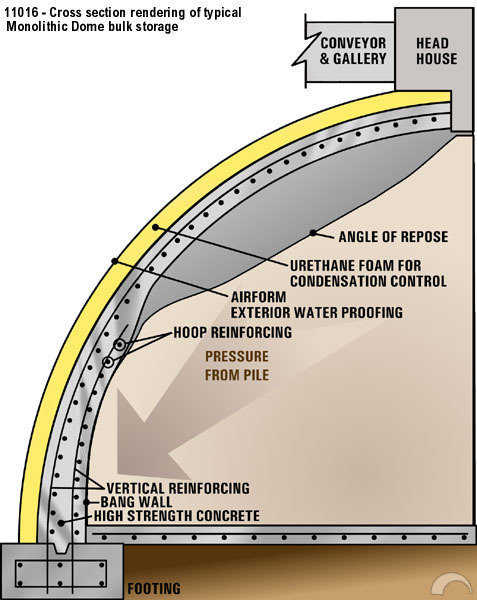A few definitions
Bulk Materials is a term used for large quantities of similar material.
Bulk storage is the term for buildings that store bulk commodities such as cement, sand, frac sand, salt, fertilizer, feed, grains, aggregates, carbon, chips, seeds, peanuts, coke, blasting powder – and the list goes on. Capacities may vary from a few hundred tons to many thousand tons.
Monolithic Dome Bulk Storage
Containment of bulk materials is accomplished by hoops of rebar (reinforcing steel bars) buried in the concrete as the Monolithic Dome is constructed. A free-flowing bulk material, such as cement piled 120 feet deep, can exert a pressure of more than 5 tons per square foot at the base of the dome.
The Monolithic Dome is engineered to contain this amount of pressure. In some of the domes this means utilizing up to a million pounds reinforcing steel. The hoops of rebar are the most efficient way of containing the enormous pressures.
Condensation is minimal in a Monolithic Dome because of the super insulation on the exterior of the concrete.
Many products store better in a cooler, insulated structure. Most bulk materials suffer when wet. They spoil, they “cement up,” they clog equipment, etc. The most common source of water in a conventional bulk storage is condensation.
Corrosion almost always accompanies condensation. Many bulk materials, such as fertilizers, are highly corrosive. By controlling condensation much of the problem goes away.
The concrete utilized in a Monolithic Dome is denser and more chemical-resistant than conventional concrete, and additives can be used to further increase resistance.
The single-ply roof membrane and the urethane insulation form a virtually waterproof exterior and prevent leakage. In extreme cases the interior of the Dome can be coated to protect the concrete – linseed oil as a protection on the interior of salt storage’s; epoxy or urethane coatings for nitrate storage’s.
Bang walls in a Monolithic Bulk Storage
Front-end loaders are used to remove most bulk materials. As they bang around within a building they may tear things up – especially in wood or metal storage buildings.
But bang walls in a Monolithic structure are resistant to loaders. The lower portion of the Monolithic Dome is an ideal bang wall. Its high density concrete is superior for resisting the scraping action of the loader bucket. The banging forces of the loader are dissipated into the hoop reinforcing, eliminating any serious point loads that tend to turn over or tear up conventional bang walls.
Strength, support, economy
Monolithic Domes are extraordinarily strong. They can safely support enormous loads. Any kind of head house can be mounted on them. These loads can include diverters, bag houses, conveyors, equipment and more. This saves money on external support. It also saves on and simplifies the processing layout.
Soft fill equipment can be safely hung from the roof of the dome. Some bulk materials seriously degrade when dropped from the top of the dome onto the pile. Chutes can be hung that will allow the material to slide without being broken and dusted. These chutes are called soft fill systems.
It costs less to store in a Monolithic Dome. Only a very cheap building can match the initial cost of a Monolithic Dome. Factor in maintenance, insurance, land costs, and especially lifespan and the Monolithic Dome will be a fraction of the cost of any other structure.
Hundreds of installations attest to their superiority.
Note: We originally published this article in the Spring 1998 Roundup and updated it in August 2011
